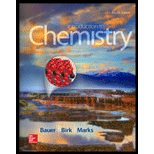
(a)
Interpretation:
The given statement that
(b)
Interpretation:
The given statement that
(c)
Interpretation:
The given statement that
(d)
Interpretation:
The given statement that
(e)
Interpretation:
The given statement that
Want to see the full answer?
Check out a sample textbook solution
Chapter 10 Solutions
Introduction to Chemistry
- Consider the data for substance X given in Exercise 117. When the temperature of 1.000 mole of X(g) is lowered from 100.0C to form X(l) at 50.0C. 28.75 kJ of heat is released. Calculate the specific heat capacity of X(g).arrow_forwardConsider the iodine monochloride molecule, ICI. Because chlorine is more electronegative than iodine, this molecule is a dipole. How would you expect iodine monochloride molecules in the gaseous state to orient themselves with respect to each other as the sample is cooled and the molecules begin to aggregate? Sketch the orientation you would expect.arrow_forwardExplain why the enthalpies of vaporization of the following substances increase in the order CH4NH3H2O, even though all three substances have approximately the same molar mass.arrow_forward
- Consider two different organic compounds, each with the formula C2H6O. One of these compounds is a liquid at room conditions and the other is a gas. Write Lewis structures consistent with this observation, and explain your answer. (Hint: The oxygen atom in both structures satisfies the octet rule with two bonds and two lone pairs.)arrow_forwardWhat is a driving force? Name two common and important driving forces, and give an example of each. What is entropy? Although the total energy of the universe is constant, is the entropy of the universe constant? What is a spontaneous process?arrow_forwardLiquid butane, C4H10, is stored in cylinders to be used as a fuel. Suppose 35.5 g of butane gas is removed from a cylinder. How much heat must be provided to vaporize this much gas? The heat of vaporization of butane is 21.3 kJ/mol.arrow_forward
- A 0.250-g chunk of sodium metal is cautiously dropped into a mixture of 50.0 g water and 50.0 g ice, both at 0C. The reaction is 2Na(s)+2H2O(l)2NaOH(aq)+H2(g)H=368kJ Assuming no heat loss to the surroundings, will the ice melt? Assuming the final mixture has a specific heat capacity of 4.18 J/gc, calculate the final temperature. The enthalpy of fusion for ice is 6.02 kJ/mol.arrow_forwardA special vessel (see Fig. 10.45) contains ice and supercooled water (both at 10C) connected by vapor space. Describe what happens to the amounts of ice and water as time passes.arrow_forwardWhat types of forces exist between the individual particles in an ionic solid? Are these threes relatively strong or relatively weak?arrow_forward
- Mercury has a heat of fusion of 2.29 kJ/mol and a heat of vaporization of 59.11 kJ/mol. What is the energy absorbed or released when 6.5 moles of liquid mercury freezes into a solid? a. -380 kJ/mol b. -15 kJ/mol c. +15 kJ/mol d. +380 kJ/molarrow_forward2. Which is the correct arrangement in terms of increasing molecular mobility? A. gas-liquid-solid B. liquid-gas-solid 3. The following elements are examples of noble gas EXCEPT for C. plasma-gas-solid D. solid-liquid-gas A. Helium B. Nitrogen C. Neon D. Xenon 4. Which of the following is an example of diatomic molecule? A. F1 B. H2 C. Na D. O4arrow_forwardWhich procedure would produce the best data for comparing the electrostatic forces between the molecules of different substances? O Heat each substance in solid form for the same amount of time. Measure the temperature of each substance. O Heat each substance in liquid form to its boiling point. Measure the temperature of each substance. O Heat each substance in solid form to its melting point. Measure the quantity of each substance that has melted. O Heat each substance in liquid form for the same amount of time. Measure the temperature of each substance.arrow_forward
 ChemistryChemistryISBN:9781305957404Author:Steven S. Zumdahl, Susan A. Zumdahl, Donald J. DeCostePublisher:Cengage Learning
ChemistryChemistryISBN:9781305957404Author:Steven S. Zumdahl, Susan A. Zumdahl, Donald J. DeCostePublisher:Cengage Learning Chemistry: An Atoms First ApproachChemistryISBN:9781305079243Author:Steven S. Zumdahl, Susan A. ZumdahlPublisher:Cengage Learning
Chemistry: An Atoms First ApproachChemistryISBN:9781305079243Author:Steven S. Zumdahl, Susan A. ZumdahlPublisher:Cengage Learning
 Living By Chemistry: First Edition TextbookChemistryISBN:9781559539418Author:Angelica StacyPublisher:MAC HIGHER
Living By Chemistry: First Edition TextbookChemistryISBN:9781559539418Author:Angelica StacyPublisher:MAC HIGHER Chemistry for Today: General, Organic, and Bioche...ChemistryISBN:9781305960060Author:Spencer L. Seager, Michael R. Slabaugh, Maren S. HansenPublisher:Cengage Learning
Chemistry for Today: General, Organic, and Bioche...ChemistryISBN:9781305960060Author:Spencer L. Seager, Michael R. Slabaugh, Maren S. HansenPublisher:Cengage Learning





